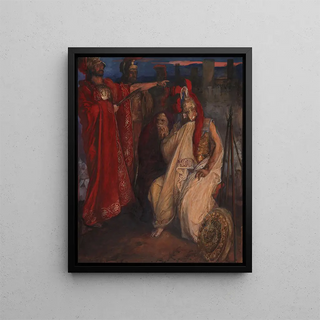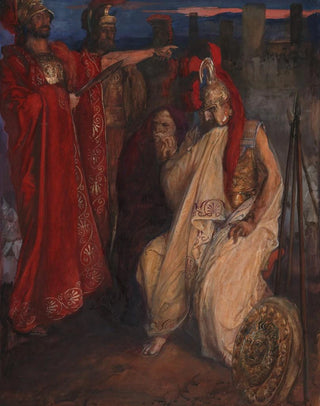Art print | Troilus and Cressida before Agamemnon's tent Cressida and her uncle - Edwin Austin Abbey


View from behind

Frame (optional)
In the vast panorama of art history, some works stand out for their ability to capture moments of dramatic tension and human emotion. The art print Troïlus et Cressida devant la tente d'Agamemnon Cressida et son oncle - Edwin Austin Abbey perfectly illustrates this essence. Inspired by Shakespeare's tragedy, this piece transports the viewer to the heart of the Trojan War, a conflict where love and loyalty clash with fate. Abbey, with his keen eye for detail and talent for expressing feelings, succeeds in bringing this iconic scene to life, inviting everyone to explore the complexities of human relationships in times of crisis.
Style and uniqueness of the work
Edwin Austin Abbey's style is characterized by a narrative approach, where each element of the composition contributes to the story the artist wishes to tell. In this work, the characters are depicted with palpable emotional intensity. Cressida, at the center of the scene, embodies vulnerability and passion, while Agamemnon, in the background, symbolizes authority and power. The colors chosen by Abbey, ranging from warm tones to darker shades, emphasize the drama unfolding before our eyes. The light, subtly manipulated, creates shadows that add visual depth, thus enhancing the tense atmosphere of the scene. Every brushstroke seems charged with meaning, testament to Abbey's skill in marrying technique and emotion.
The artist and his influence
Edwin Austin Abbey, born in 1852, is often regarded as one of the great masters of illustration and narrative painting of the late 19th century. His work is deeply influenced by literature, particularly Shakespeare's works, which he often illustrated. Abbey established a unique link between visual art and literary narration, allowing him to create works that resonate with emotional depth and narrative richness. Drawing inspiration from universal themes such as love, betrayal, and sacrifice, Abbey was able to touch

Matte finish

View from behind

Frame (optional)
In the vast panorama of art history, some works stand out for their ability to capture moments of dramatic tension and human emotion. The art print Troïlus et Cressida devant la tente d'Agamemnon Cressida et son oncle - Edwin Austin Abbey perfectly illustrates this essence. Inspired by Shakespeare's tragedy, this piece transports the viewer to the heart of the Trojan War, a conflict where love and loyalty clash with fate. Abbey, with his keen eye for detail and talent for expressing feelings, succeeds in bringing this iconic scene to life, inviting everyone to explore the complexities of human relationships in times of crisis.
Style and uniqueness of the work
Edwin Austin Abbey's style is characterized by a narrative approach, where each element of the composition contributes to the story the artist wishes to tell. In this work, the characters are depicted with palpable emotional intensity. Cressida, at the center of the scene, embodies vulnerability and passion, while Agamemnon, in the background, symbolizes authority and power. The colors chosen by Abbey, ranging from warm tones to darker shades, emphasize the drama unfolding before our eyes. The light, subtly manipulated, creates shadows that add visual depth, thus enhancing the tense atmosphere of the scene. Every brushstroke seems charged with meaning, testament to Abbey's skill in marrying technique and emotion.
The artist and his influence
Edwin Austin Abbey, born in 1852, is often regarded as one of the great masters of illustration and narrative painting of the late 19th century. His work is deeply influenced by literature, particularly Shakespeare's works, which he often illustrated. Abbey established a unique link between visual art and literary narration, allowing him to create works that resonate with emotional depth and narrative richness. Drawing inspiration from universal themes such as love, betrayal, and sacrifice, Abbey was able to touch






